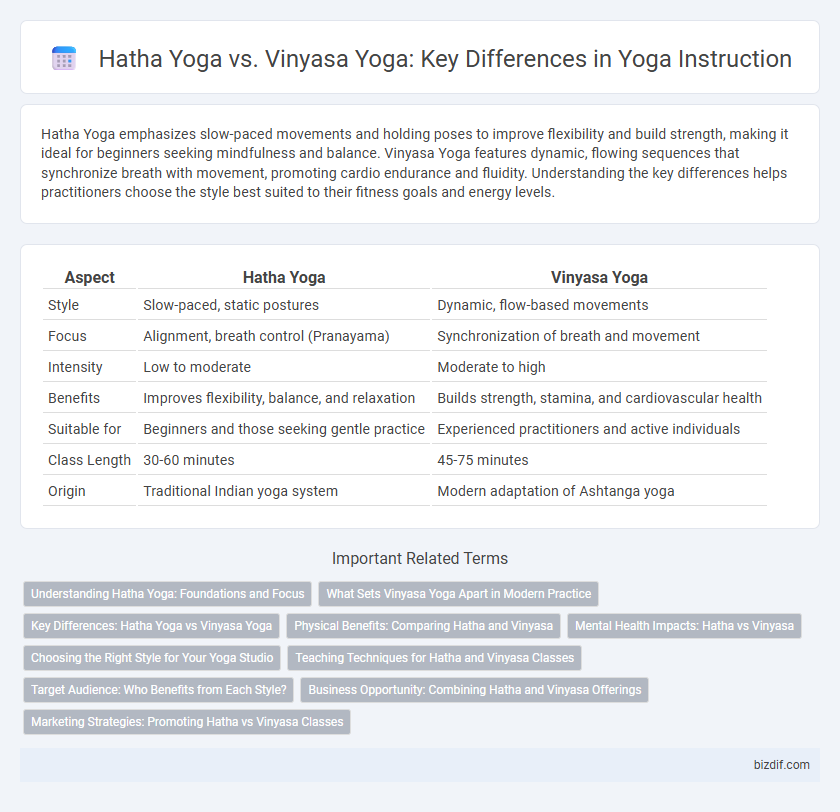Hatha Yoga emphasizes slow-paced movements and holding poses to improve flexibility and build strength, making it ideal for beginners seeking mindfulness and balance. Vinyasa Yoga features dynamic, flowing sequences that synchronize breath with movement, promoting cardio endurance and fluidity. Understanding the key differences helps practitioners choose the style best suited to their fitness goals and energy levels.
Table of Comparison
| Aspect | Hatha Yoga | Vinyasa Yoga |
|---|---|---|
| Style | Slow-paced, static postures | Dynamic, flow-based movements |
| Focus | Alignment, breath control (Pranayama) | Synchronization of breath and movement |
| Intensity | Low to moderate | Moderate to high |
| Benefits | Improves flexibility, balance, and relaxation | Builds strength, stamina, and cardiovascular health |
| Suitable for | Beginners and those seeking gentle practice | Experienced practitioners and active individuals |
| Class Length | 30-60 minutes | 45-75 minutes |
| Origin | Traditional Indian yoga system | Modern adaptation of Ashtanga yoga |
Understanding Hatha Yoga: Foundations and Focus
Hatha Yoga emphasizes foundational postures and breath control, promoting physical alignment and mental clarity through static holds and mindful breathing techniques. This practice develops strength, flexibility, and balance at a steady pace, making it accessible for beginners seeking to build core skills. Understanding Hatha Yoga's focus on deliberate, slow movements helps practitioners connect deeply with body awareness and cultivate relaxation.
What Sets Vinyasa Yoga Apart in Modern Practice
Vinyasa Yoga distinguishes itself in modern practice through its dynamic flow that synchronizes breath with movement, creating a continuous sequence of postures. Unlike the more static and alignment-focused Hatha Yoga, Vinyasa emphasizes fluid transitions and cardiovascular engagement, appealing to practitioners seeking both strength and flexibility. This energetic style fosters mindfulness and stamina, making it a popular choice for those aiming for a vigorous yet meditative workout.
Key Differences: Hatha Yoga vs Vinyasa Yoga
Hatha Yoga emphasizes slow-paced, static postures aimed at building strength and flexibility through mindful breathing and alignment, making it accessible for beginners and focused on relaxation. Vinyasa Yoga incorporates dynamic, flowing sequences that synchronize breath with movement, promoting cardiovascular endurance and agility with continuous transitions between poses. The key difference lies in Hatha's deliberate, steady approach versus Vinyasa's energetic, rhythm-based practice, catering to different fitness levels and goals.
Physical Benefits: Comparing Hatha and Vinyasa
Hatha Yoga emphasizes static postures and deep breathing, improving flexibility, muscle strength, and balance through slower, controlled movements. Vinyasa Yoga incorporates dynamic flow sequences that enhance cardiovascular endurance, build core strength, and increase overall body tone by linking breath with continuous motion. Both styles boost physical fitness, but Hatha suits beginners focusing on alignment, while Vinyasa appeals to those seeking a more vigorous, aerobic workout.
Mental Health Impacts: Hatha vs Vinyasa
Hatha Yoga emphasizes slow, mindful movements and deep breathing techniques, promoting relaxation and reducing anxiety by calming the nervous system. Vinyasa Yoga incorporates dynamic flows and synchronized breathwork, which can boost mood and alleviate symptoms of depression through increased cardiovascular activity and endorphin release. Both styles enhance mental clarity and stress management but cater to different needs: Hatha for gentle mindfulness and Vinyasa for energetic mental stimulation.
Choosing the Right Style for Your Yoga Studio
Hatha Yoga emphasizes slow, deliberate poses with a focus on alignment and breath control, making it ideal for beginners and those seeking a meditative practice. Vinyasa Yoga incorporates flowing sequences and dynamic movements synchronized with breath, appealing to students who prefer a more vigorous and cardio-intensive workout. Selecting the right style for your yoga studio depends on your target demographic's fitness levels and preferences for either a gentle or energetic yoga experience.
Teaching Techniques for Hatha and Vinyasa Classes
Hatha Yoga teaching techniques emphasize slow, deliberate postures with detailed alignment cues to enhance body awareness and foundational strength. In contrast, Vinyasa Yoga instruction focuses on fluid movement synchronized with breath, using dynamic sequencing that builds heat and endurance. Both styles prioritize mindful breathing but differ in pacing and energy flow to suit diverse practitioner needs.
Target Audience: Who Benefits from Each Style?
Hatha Yoga suits beginners and those seeking a slower, more deliberate practice focused on alignment and breath control, benefiting individuals with limited flexibility or those aiming to reduce stress. Vinyasa Yoga appeals to active practitioners desiring a dynamic, flowing sequence that builds strength and cardiovascular endurance, ideal for fitness enthusiasts and people looking for a vigorous workout. Both styles offer mental clarity and improved balance but cater to differing fitness levels and practice goals.
Business Opportunity: Combining Hatha and Vinyasa Offerings
Combining Hatha and Vinyasa yoga classes creates a diverse portfolio that attracts a broader client base, enhancing studio revenue potential. Hatha's slower pace appeals to beginners and those seeking relaxation, while Vinyasa's dynamic flow targets fitness enthusiasts and advanced practitioners. Offering both styles positions instructors to maximize market reach and increase class attendance consistently.
Marketing Strategies: Promoting Hatha vs Vinyasa Classes
Promoting Hatha Yoga classes effectively targets practitioners seeking slow-paced, alignment-focused sessions emphasizing breath control and mindfulness, appealing to beginners and those interested in stress relief. Marketing Vinyasa Yoga highlights its dynamic flow and cardiovascular benefits, attracting fitness enthusiasts and active individuals looking for energetic, fluid movement. Utilizing social media campaigns featuring class previews, testimonials, and instructor expertise drives engagement for both, with targeted keywords such as "gentle yoga," "beginner-friendly," and "flow yoga" optimizing search visibility.
Hatha Yoga vs Vinyasa Yoga Infographic

 bizdif.com
bizdif.com